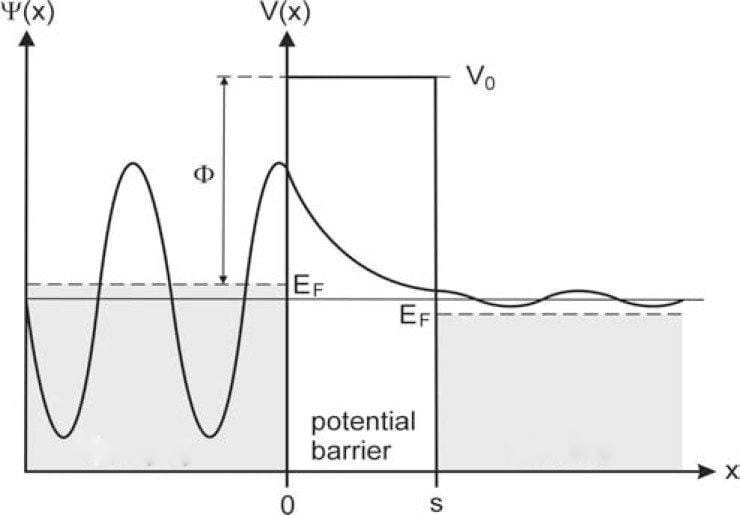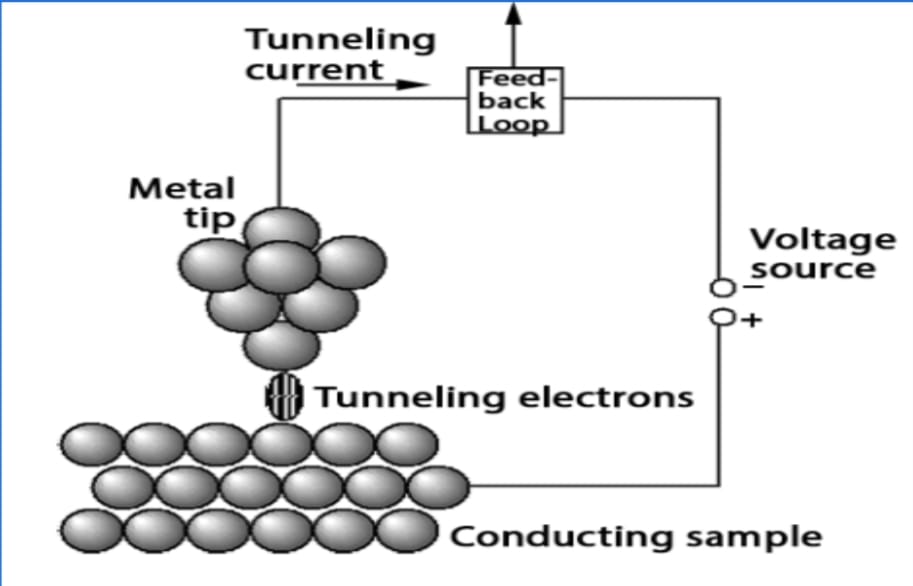The Phenomenon of Quantum Tunneling and How It's Used in Scanning Tunneling Microscopy
-Adithya R
What Is Quantum Tunneling?
- Say you have a ball rolling up a hill such that the ball’s potential energy at the top of the hill would be higher than the current kinetic energy of the ball. According to classical physics, the ball would only roll up to a certain height and start to roll back since its energy is not enough to cross the peak of the hill. The hill, in this case, is considered an energy barrier which disallows the ball to reach the other side of the hill. Let’s apply this concept to sub-atomic particles, such as an electron. When we consider the particle-like nature of an electron, we can still say the electron would not be able to pass the energy barrier. But, the study of quantum mechanics has led to the discovery of the dual nature of matter, i.e., they behave both as particles and waves. When we consider the wave-like properties of an electron and plot the electron's wave function against its position around the energy barrier, we observe that the electron's wave function decays exponentially through the barrier rather than being stopped or reflected, as shown in the figure below.
When we consider the wave-like properties of an electron and plot the electron's wave function against its position around the energy barrier, we observe that the electron's wave function decays exponentially through the barrier rather than being stopped or reflected, as shown in the figure below.

This behavior is seen in waves and hence can be exhibited by anything with a significant wave-like nature (particles with very low mass). The barrier, in the case of an electron, can be a physical barrier or a potential barrier, which is used in a Scanning Tunneling Microscope (STM).
THE WORKING OF A SCANNING TUNNELING MICROSCOPE
The scanning tunneling microscope works by scanning a sharp metal wire tip (probe) very close to the surface of a sample. This tip is connected to the sample via a circuit, and a voltage is applied between the sample and the tip, which causes current flow between them.Since there is no conductor between the probe tip and the sample's surface, the electrons must cross the gap between them, which acts as an energy barrier. Hence, the electrons will have to "tunnel" through that energy barrier to complete the circuit, facilitating continuous current flow. This tunneling effect is observed only when the gap is very small (about 1 nanometre).
The flow of electrons increases when the gap is smaller and decreases when the gap is larger. So, a feedback loop is used to monitor the current flow and maintain a constant current by moving the tip up and down, depending on the structure of the surface, such that the gap is kept constant.
This is done along the entire surface of the sample hence mapping the surface on an atomic scale (due to the demand for high precision in the distance between the sample and the tip for the tunneling current to flow). The top-most section, which has already been mapped, is then removed, and the same process is repeated for the subsequent sections until a complete 3D image of the sample's atomic structure is obtained.

THE NEED FOR TUNNELLING ELECTRONS
To understand the necessity for quantum tunnelling in this kind of mapping, we need to take care of two things that are imperative to the mapping of structures on an atomic scale:- A small change in height on the surface of the sample, even on an angstrom level, has to be recorded, to obtain the atomic structure.
- The direction of the flow of electrons must be controlled such that the electrons flow only between the tip and point on the sample that’s directly below the tip, to make sure the image is accurate.
References:
https://www.researchgate.net/publication/345631159_Quantum_tunnelling
https://www.nanoscience.com/techniques/scanning-tunneling-microscopy/
https://www.researchgate.net/figure/Quantum-tunnelling-effect-Illustrated-is-the-exponential-damping-of-a-wave-function_fig2_256613933
https://safeswisscloud.com/en/blog/1981-scanning-tunneling-microscope-stm/